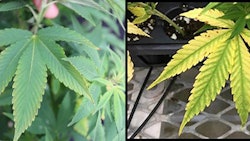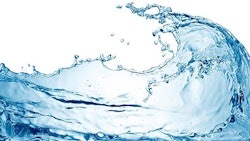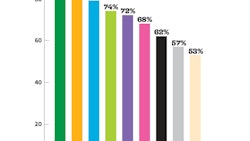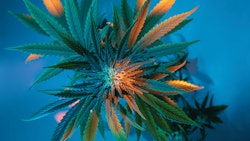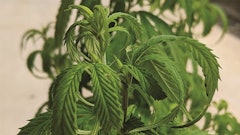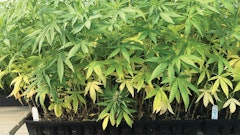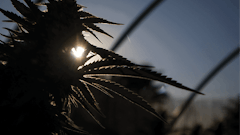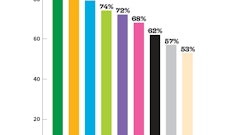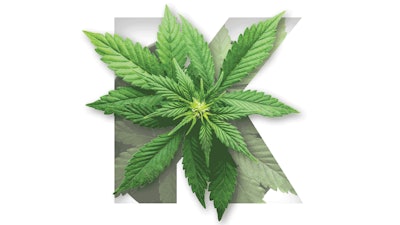
Potassium (K) is often overlooked in plant nutrition because nitrogen (N) is typically in the spotlight. But potassium is perhaps the most important of the macronutrients, as it’s essential for stomatal activity. Stomatal activity is important, as it drives plant uptake and regulation of water, which is vital to ensure all parts of the plant receive adequate hydration and to provide drought stress tolerance. Potassium makes sure water can get from the roots all the way to the very top of the plant.
In plants, K is a mobile element, which means it can move or translocate from older portions of the plant to satisfy the demand for new growth. As a result, symptoms of potassium deficiency are initially observed in the older leaves as the plant moves potassium out of them and into the newly developing leaves and floral material.
To better understand ideal potassium rates for cannabis, in 2020, North Carolina State University researchers explored K fertility rates for Cannabis sativa ‘BaOx’ plants to determine how differing K rates would impact cannabis during its lifecycle from the vegetative stage to flowering. Here are some highlights from the NCSU research:

Deficiency Symptoms
Symptoms of potassium deficiency can develop quickly. In earlier research conducted at NCSU, we induced nutrient disorders in cannabis and observed visual symptoms within six weeks after withholding K. Potassium deficiency develops first on the lower or older leaves (Fig. 1). For highly branched systems such as the “Screen of Green” method, which allows growers to evenly position branches in the canopy while offering support to developing flowers and avoiding bare spaces, it may be difficult to evaluate the lower leaves due to the thick upper canopy. In these systems, looking at the older leaves on the main branches that come off the central stem, sometimes referred to as primary and secondary branches, will prove useful.
Potassium deficiency will occur when K resources are deprived or severely limited. As a result of this deprivation, certain physical foliar symptoms first manifest as a general yellowing of the leaflet margins (Fig. 1). This yellowing advances, resulting in necrotic margins that appear burnt (Fig. 2). If the plant does not receive K, the older and/or lower leaves will develop severely necrotic margins and eventually abscise (Fig. 2). In the flowering stage, the resultant buds contained reproductive leaves (leaves present on and within the flower) with marginal yellowing and leaves that were severely necrotic (Fig. 2). Different plant portions and different stages also result in varying symptoms such as stunted floral growth or lower leaves on the flowers turning yellow and necrotic (Fig. 3).
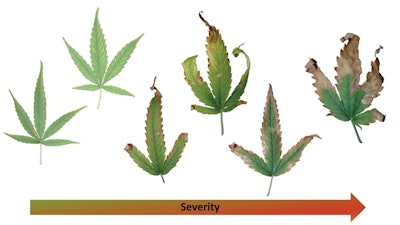
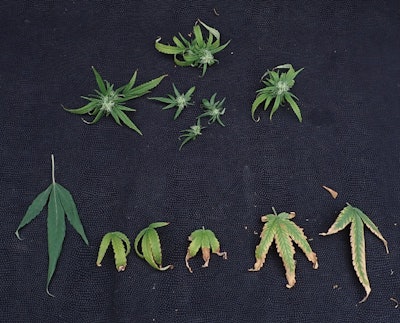
Potassium Fertility Rates
In a follow-up study, NCSU researchers looked at six fertility rates for potassium (0, 19.5, 39.1, 77.9, 156.1 and 234 ppm K). We explored how various rates of K impacted above-ground biomass production and nutrient accumulation in leaf tissue.
We noted how vegetative biomass was optimized depending on the rate of K and the growth stage. During this experiment, plants received continuous fertilizer with all the necessary macro and micro nutrients, with only K varying. At each stage, four plants were harvested to account for overall plant performance at key stages of growth (vegetative, pre-flowering and flowering). During the early vegetative stage (first eight weeks of growth under 18-hour days), overall plant dry matter production in the vegetative stage increased with K levels up to 39.1 ppm K. Adding more potassium after that point did not produce more biomass. For the pre-flowering stage (four weeks after short-day induction with 12 hours light and 12 hours darkness), the same trend was observed, with K levels of 39.1 ppm proving optimal to maximize biomass production (Fig. 4). However, at final harvest (eight weeks after short days), the highest potassium concentration (234 ppm K) resulted in the greatest biomass.
We explored potassium allocation and accumulation in a previous article, “Put Your Fertilizer Program to the Test,” published in the October 2020 issue of Cannabis Business Times. This research demonstrated that after floral initiation, very little potassium is taken up by the plant as it opts to reallocate potassium from the stem and leaf tissue to the developing flowers and seeds.
Based on the findings, it’s important that growers periodically take leaf tissue samples from the most recently mature leaves as part of a nutrient monitoring program. For this study, plants grown under a full Hoagland solution (234 ppm K) resulted in higher leaf tissue values than the values for optimizing biomass production (40 to 80 ppm K). If utilizing a full Hoagland solution, leaf tissue ranges were 2.78% to 3.37% K of the total leaf tissue biomass for vegetative stages, 1.4% to 2.98% K for pre-flowering, and 2.51% to 3.10% K for flowering stages. If utilizing the lower range of 40 to 80 ppm K, leaf tissue values ranged from 1.95% to 2.78%, 0.59% to 1.40%, and 1.14% to 1.71%, respectively, for the vegetative, pre-flowering and flowering stages.
If seeking stage-specific recommendations, the above leaf tissue values may prove useful. An overall range that would encompass all life stages and also err on the side of caution would be between 1.7% and 2.8% leaf tissue. More research is needed to determine why adequate biomass production occurred under much lower K fertilization than typically recommended.
For this study, cannabinoid production was not analyzed. However, recent work from Israel (Saloner and Bernstein, 2022) explored similar potassium rates and the impact on cannabinoids and terpenes. They applied different K fertility treatments (15, 60, 100, 175 and 240 ppm K) and explored many different plant growth and development metrics. Overall, they concluded that most cannabinoids and terpenes decreased with higher concentrations of K fertilization. To ensure plant health and function as well as yield, they recommended fertilization rates of 60 ppm K.
This rate falls within our recommended range of 40 to 80 ppm, resulting from our NCSU work for optimal biomass production.
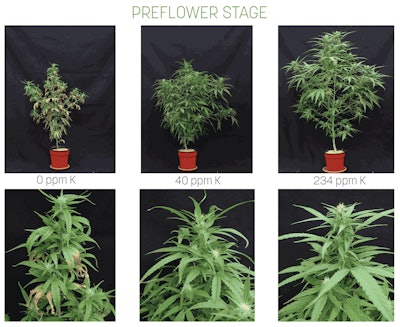
Conclusions
Ultimately, the optimal rate for potassium fertility depends largely on your end goal as a producer—whether you are producing cannabis for floral material, an extraction market or clonal material.
Based on this understanding of biomass production and differences in veg and bloom times that can occur, a recommended K rate would be between 40 and 80 ppm K. However, based on industry knowledge and conventional wisdom, these numbers are much lower than normally recommended. An expanded range between 60 to 120 ppm K may be prudent. We recommend that growers start at the higher end of K fertilization and experiment with lower rates on a smaller portion of plants, according to the specific management needs and nuances of each operation and cultivar.
For growers producing clones, a higher K concentration between 80 to 100 ppm may be needed. Higher concentrations in this system ensure adequate biomass production and allow for K recovery as plant biomass is being removed. For floral or distillate markets, lower K concentrations of 60 ppm K may be needed to ensure adequate floral production and cannabinoid concentrations (Fig. 4). In these systems, utilizing a higher K fertility early on will pre-load K resources into the plants for reallocation during the reproductive stages.
Of course, it’s difficult to make broad sweeping recommendations for all operations and varieties. These recommendations should be used as guidelines. Conduct independent tests before making facility-level changes to explore ideal K fertilization for optimal plant growth.










